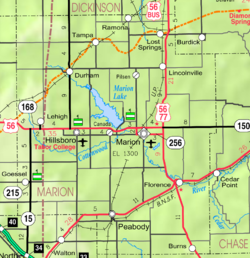19th century
In 1802, Spain returned most of the land to France. In 1803, most of the land for modern day Kansas was acquired by the United States from France as part of the 828,000 square mile Louisiana Purchase for 2.83 cents per acre.
In 1854, the Kansas Territory was organized, then in 1861 Kansas became the 34th U.S. state. In 1855, Marion County was established within the Kansas Territory, which included the land for modern day Lehigh. [4]
The source of the Lehigh name was not well documented. One of the rumors is the city being slightly higher altitude which was "lay high" above the prairie, the other rumor that it was named by representatives of Lehigh County, Pennsylvania who came to Kansas and considered settling the area in the 1870s or 1880s. [5]
Four and one-half miles north of Lehigh is the junction of the old Santa Fe Trail and Chisolm Trail, which is near the site of the municipal water well for the city. The Santa Fe Trail was active across Marion County from 1821 to 1866, [6] and the Chisholm Trail was active from 1867 to 1871. [7]
As early as 1875, city leaders of Marion held a meeting to consider a branch railroad from Florence. In 1878, Atchison, Topeka and Santa Fe Railway and parties from Marion and McPherson counties chartered the Marion and McPherson Railway Company. [8] In 1879, a branch line was built from Florence to McPherson, in 1880 it was extended to Lyons, in 1881 it was extended to Ellinwood. [9] The line was leased and operated by the Atchison, Topeka and Santa Fe Railway. The line from Florence to Marion was abandoned in 1968. [10] In 1992, the line from Marion to McPherson was sold to Central Kansas Railway. In 1993, after heavy flood damage, the line from Marion through Lehigh to McPherson was abandoned and removed. The original branch line connected Florence, Marion, Canada, Hillsboro, Lehigh, Canton, Galva, McPherson, Conway, Windom, Little River, Mitchell, Lyons, Chase and Ellinwood. The former 1879 Lehigh rail depot was moved to Walton and sits next to Highway 50. [11] [12]
A post office was established at Lehigh on April 23, 1880. [13]
Lehigh was platted in 1881. [14]
20th century
Lehigh was incorporated in 1901 and at the time of the 1910 census had a population of 385. At one time it boasted a bank, several mercantile businesses, and a German weekly Mennonite newspaper, Das Echo, started in 1897. [15]
The National Old Trails Road, also known as the Ocean-to-Ocean Highway, was established in 1912, and was routed through Lehigh, Hillsboro, Marion, Lost Springs.









